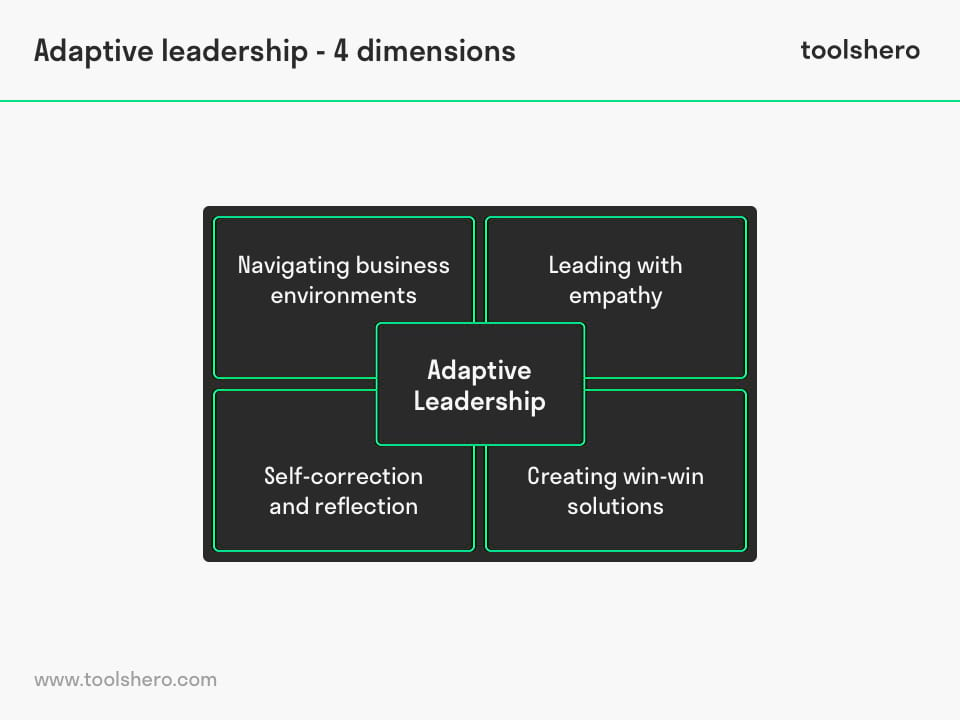Adaptive Leadership theory explained

Adaptive Leadership: this article describes the Adaptive Leadership theory, developed by Ron Heifetz and Marty Linsky in a practical way. The article starts with a general theory of adaptive leadership and its origin, followed by the advantages of this leadership style and information about its 4 dimensions. Enjoy reading!
What is Adaptive Leadership? The theory
Adaptive leadership is a practical leadership framework that helps individuals and organisations to adapt to changing environments and effectively respond to recurring problems. First, the change itself needs to be considered to subsequently take on challenges and respond to the change.
Research by Ron Heifetz and Marty Linsky at Harvard University formed the basis for Adaptive Leadership.
Recurring problems
Every organisation is confronted with persistent, recurring problems. They often fall back on obvious solutions such as applying new technologies, recruiting experts or improving (communication) processes.
In most cases, this is done in a hierarchical way with the top layer of management being responsible for finding the right solutions. An adaptive challenge allows problems to be identified more accurately and involves the entire organisation in the search for possible solutions.
Adaptive Leadership can help when there are no easy solutions available. It’s a critical skill for anyone looking for systematic changes in an increasingly complex world. Adaptive leaders learn to control the context through experiments.
They cultivate a diversity of viewpoints in order to generate a large number of options. They lead with empathy, reward their employees’ performance with autonomy and independence and find winning solutions for all stakeholders.
The advantages of Adaptive Leadership
It’s often thought that leaders are dominant within an organisation and want to use their strong personalities to impose their will. This hierarchical top-down leadership style hasn’t worked for a long time. It hinders the flow of information in companies, undermining cooperation and unity between teams and departments.
Adaptive Leadership has a number of advantages. Every member of the organisation is involved and learns to understand the cause of a recurring problem.
It also leads to better understanding between all hierarchical layers and enables everyone to be open to experiments and creating lasting changes.
Adaptive Leadership : Four dimensions
Adaptive leaders create conditions that enable dynamic networks and environments to achieve common goals in an environment of uncertainty.
Adaptive Leadership focuses on four dimensions; navigating business environments – leading with empathy – learning through self-correction and reflection – creating win-win solutions. There’s no universal check-list for Adaptive Leadership, but these four dimensions can help leaders to better prepare for unpredictable business environments.

Figure 1 – the four dimensions of Adaptive leadership
1. Navigating business environments
Adaptive leaders should embrace uncertainty and encourage the organisation to look for new approaches.
It’s about the context; rules and procedures should be left behind. Sticking to rules and procedures can actually be counter-productive. Learning from changes will lead to the best solution.
By developing different perspectives, you get a wide range of options. Employees are encouraged to go beyond their traditional way of thinking and find creative solutions by thinking in possibilities rather than in limitations.
The Adaptive Leader will inspire the team and encourage them to apply their best skills. It’s important to discuss things with each other, since that will lead to new insights.
Every member of the organisation is equally important. The role of the leader should therefore go to the person or group most-suited to make a particular decision.
2. Leading with empathy
Adaptive leaders create a group attitude instead of an atmosphere of divide and conquer. An adaptive leader will understand alternative perspectives and ideas and be able to share them with others by looking at the organisation through the eyes of others. They have the ability to respond with empathy, allowing them to influence co-workers, competitors and other stakeholders.
In addition, adaptive leaders will reward their employees with autonomy. It’s about what employees achieve, not about completing their tasks or getting through the work day.
Instead of a focus on financial incentives (extrinsic task motivation), they emphasise working independently and managing one’s own activities, cooperation and recognition (intrinsic task motivation). Adaptive leaders understand that it’s about their employees’ actual effort.
3. Learning through self-correction and reflection
Adaptive leaders encourage experimentation. Of course some experiments will fail, but those failures can serve as lessons for the future. Falling and getting back up teaches us that many roads can lead to success.
Adaptive leaders would do well though to offer their people the chance to reflect on both successes and failures. By identifying mistakes and problems properly and in a timely manner, they can be tracked down, filtered and decoded, giving the organisation a chance to respond to them.
Adaptive leaders ensure that their organisation is always aware of what’s going on outside it and what customers are thinking. All this information can then be included in the strategy.
Adaptive leaders also allow decisions to be made at lower levels in the organisation and minimise the number or organisational layers.
4. Create win-win solutions
An adaptive leader values platforms for cooperation and builds on them. The organisation’s success often depends on the involvement of an extended network of stakeholders.
Technology even makes it possible to involve suppliers and customers in complex issues such as product innovation and product changes. Their knowledge and insight is worth a lot and a lot of a company’s influences come from outside.
Adaptive leaders who practice Adaptive Leadership do more than just focus on profit and revenue growth. They safeguard the continuity of their organisations’ business models and explore opportunities to have economic and social vectors play a role in these.
What is an example of Adaptive Leadership?
Many regional broadcasters are confronted with a strongly changing landscape; the media usage of their audiences is no longer limited to radio and television, but has become much more interactive with a lot of emphasis on social media.
As a rigid organisation, a regional broadcasting company can continue focusing on radio and television programmes, finding money for them and value old-fashioned measurements such as viewer-ship and listener-ship.
Letting go of Hierarchical Leadership and responding more adaptively to this changing environment, allows the board and editors to create a climate in which all employees recognise that their input is valued.
Audience ideas and opinions are also considered and the organisation can benefit from experimenting using this valuable information and by focusing more on social media. Monitoring will show what does and what doesn’t get a response, leading to successes being continued and failures being abandoned.
Adaptive Leadership is Adaptive change
Organisations who operate in an unpredictable environment can benefit from Adaptive Leadership and its four dimensions. Not all environments or challenges are equal, however. Just like different environments require different organisational models, there are also different leadership styles to choose from.
Over time, an organisation can transition from one leadership style to another. It can, for instance, be smart to switch to a more experimental style when a formerly stable industry is in upheaval. When it becomes stable again, going to an analytical can be more appropriate. Adaptive leadership is deliberate, real-time evolution.
It’s Your Turn
What do you think? Is the Adaptive Leadership style still applicable in today’s modern business world? Do you recognize the practical explanation or do you have more additions? What are your success factors for good and flexible leadership?
Share your experience and knowledge in the comments box below.
More information
- Heifetz, R. A., Grashow, A., & Linsky, M. (2009). The practice of adaptive leadership: Tools and tactics for changing your organization and the world. Harvard Business Press.
- Obolensky, M. N. (2014). Complex adaptive leadership: Embracing paradox and uncertainty. Gower Publishing.
- Randall, L. M., & Coakley, L. A. (2007). Applying adaptive leadership to successful change initiatives in academia. Leadership & Organization Development Journal, 28(4), 325-335.
- Yukl, G., & Mahsud, R. (2010). Why flexible and adaptive leadership is essential. Consulting Psychology Journal: Practice and Research, 62(2), 81.
How to cite this article:
Mulder, P. (2017). Adaptive Leadership (Heifetz & Linsky). Retrieved [insert date] from Toolshero: https://www.toolshero.com/leadership/adaptive-leadership/
Original publication date: 12/23/2017 | Last update: 07/29/2023
Add a link to this page on your website:
<a href=”https://www.toolshero.com/leadership/adaptive-leadership/”>Toolshero: Adaptive Leadership (Heifetz & Linsky)</a>













3 responses to “Adaptive Leadership theory explained”
Really like the simplicity and logic of Adaptive Leadership. Why hasn’t to taken off more???
Adaptive leadership is a critical skill that a leader needs to possess to handle technical and adaptive challenges differently. It is a framework that helps a pacemaker to drive organizational amendments and produce learning ventures. It is a complementary approach to leadership which focuses on uncovering local solutions to complex issues.
Thank you for your comment, Jamal.